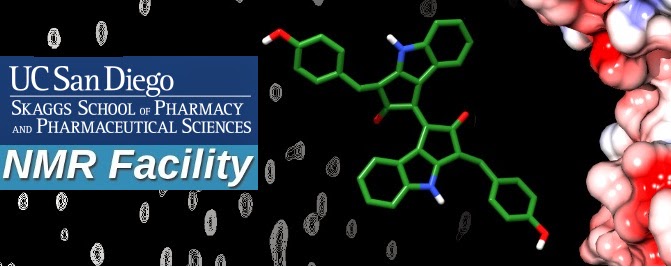Non uniform sampling (NUS) speeds NMR experiments by sampling a fraction of the data traditionally collected and predicting the rest. The data to be collected is defined by a sampling schedule and many different sampling schedules can be defined for a given level of sampling. A previous post showed that different schedules produce different results. If the best performing schedule for one compound also performs well for other compounds then that schedule could be defined as the default to give the best possible performance. To determine if this is true I compared NUS spectra obtained using the same sampling schedules on three different compounds, strychnine, ethyl benzene and cholesteryl acetate.
Monday, November 4, 2019
Wednesday, October 9, 2019
Comparing NUS reconstruction software
Non uniform sampling (NUS) reduces the time taken to record multidimensional NMR spectra by collecting a fraction of the usual data points and predicting the rest. There are many algorithms to predict the skipped data points and even multiple implementations of the same algorithm. Here I compare two implementations of the Iterative Soft Threshold (IST) algorithm, one provided by nmrPipe and the other by SMILE.
Monday, September 9, 2019
Comparing NUS sampling schedules
Non uniform sampling (NUS) allows multi-dimensional NMR data to be collected in a quarter or less of the traditional time. This is done by collecting only a fraction of the usual data and predicting the missing points. The data that is collected is defined by a sampling schedule and many different ways of creating these sampling schedules have been published. Several papers have reported that not all sampling schedules, even those created in the same way, produce the same quality spectra. Here, the spectra produced by different sampling schedules are compared and methods for assessing the quality of NUS spectra trialed.
Thursday, August 1, 2019
Measuring pKa
A compound's pKa is a fundamental parameter that influences its solubility, membrane permeability, and protein binding and thus its ADME properties. Knowing the pKa of a compound can help with rational design and formulation. Because of its importance the FDA now requires new drug applications to report the compound's pKa. NMR is one of the ways to measure pKas and in this post I'll describe how its done.
Monday, June 3, 2019
Field strength
Everybody knows bigger magnets make for better NMRs, right? But exactly what does a stronger magnetic field do for you in terms of the spectra you record? The short answer is increased sensitivity and resolution. Read on for more details.
Monday, May 6, 2019
Residual chemical shift anisotropy
Residual chemical shift anisotropy (RCSA) is another parameter that is being incorporated into the structure elucidation toolbox. As its name suggests, RCSA is similar to residual dipolar coupling (RDC) in that it requires partial alignment of the sample so that differences between the aligned and unaligned states can be measured.
Thursday, April 4, 2019
Residual dipolar coupling
Traditionally, NMR structure elucidation has relied upon analysis of chemical shifts, coupling constants, and NOEs. In most cases this is sufficient but occasionally mistakes have been made. Recently, additional NMR observables have been introduced to the structure elucidation toolkit that reduce the chances of getting things wrong. One of these observables is residual dipolar coupling or RDC.
Wednesday, March 6, 2019
Tuning and matching
Another one of the steps when acquiring an NMR spectrum is tuning and matching the probe. Tuning and matching optimises the efficiency of the radio frequency pulses and maximises sensitivity. For anything but the most simple pulse sequences tuning and matching the probe will give you a better spectrum.
Tuesday, February 5, 2019
Shimming
Shimming is another one of those things you have to do to record an NMR spectrum but what exactly is it, and why does it have to be done? Put simply, shimming is the process of optimising the magnetic field around your sample. Shimming your sample will produce spectra with sharper peaks and better resolution.
Subscribe to:
Posts (Atom)
